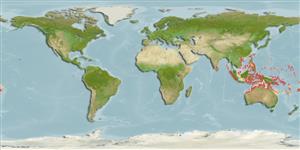Common names from other countries
>
Ovalentaria/misc (Various families in series Ovalentaria) >
Pseudochromidae (Dottybacks) > Pseudochrominae
Etymology: Pseudochromis: Greek, pseudes = false + Greek, chromis = a fish, perhaps a perch (Ref. 45335).
More on author: Schultz.
Environment: milieu / climate zone / depth range / distribution range
Écologie
marin récifal; profondeur 0 - 30 m (Ref. 37816). Tropical; 26°N - 23°S
Western Pacific: Philippines and Taiwan to Vanuatu, south to northwestern Australia and New Caledonia; eastern Caroline and Marshall Islands in Micronesia.
Taille / Poids / Âge
Maturity: Lm ? range ? - ? cm
Max length : 8.0 cm TL mâle / non sexé; (Ref. 9710)
Épines dorsales (Total) : 3; Rayons mous dorsaux (Total) : 24 - 27; Épines anales: 3; Rayons mous anaux: 11 - 14. Yellow tail and yellow spots on body scales that form dotted lines (Ref. 48635).
Inhabits lagoon and seaward reefs (Ref. 1602). Solitary or in pairs under ledges or in caves (Ref 90102).
Life cycle and mating behavior
Maturities | Reproduction | Spawnings | Egg(s) | Fecundities | Larves
Myers, R.F., 1991. Micronesian reef fishes. Second Ed. Coral Graphics, Barrigada, Guam. 298 p. (Ref. 1602)
Statut dans la liste rouge de l'IUCN (Ref. 130435)
CITES (Ref. 128078)
Not Evaluated
Menace pour l'homme
Harmless
Utilisations par l'homme
Outils
Articles particuliers
Télécharger en XML
Sources Internet
Estimates based on models
Preferred temperature (Ref.
115969): 26.3 - 29.3, mean 28.6 (based on 1905 cells).
Phylogenetic diversity index (Ref.
82804): PD
50 = 0.5000 [Uniqueness, from 0.5 = low to 2.0 = high].
Bayesian length-weight: a=0.00490 (0.00187 - 0.01281), b=3.11 (2.88 - 3.34), in cm Total Length, based on LWR estimates for this (Sub)family-body shape (Ref.
93245).
Niveau trophique (Ref.
69278): 3.5 ±0.5 se; based on size and trophs of closest relatives
Fishing Vulnerability (Ref.
59153): Low vulnerability (10 of 100).
